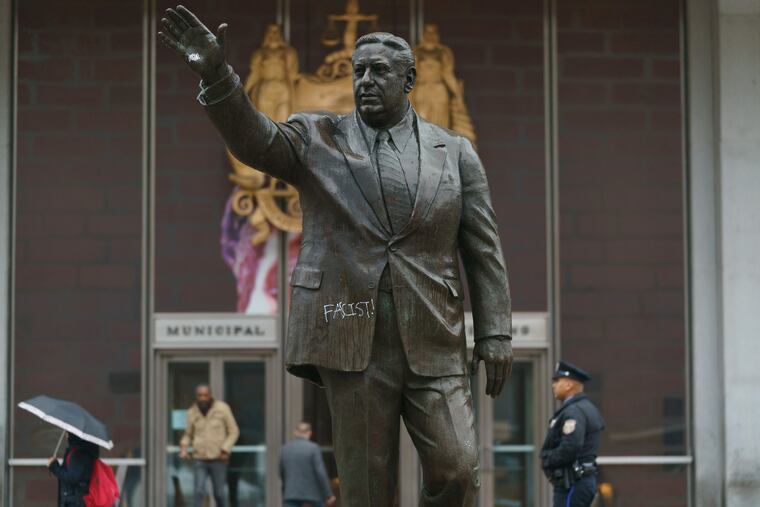The Frank Rizzo statue’s future is bungled yet again | Opinion
After years of repeated public calls for the statue's removal, this week saw another round of defacement and another change to its movement timeline.

It’s time for the Rizzo statue to go, again.
After years of repeated public calls for its removal and, just this week, both another round of defacement and the news that the statue’s move has been delayed yet again, a city otherwise known as a world capital for public art still finds itself at a point of reckoning with its most notorious statue.
A monument is a statement of power and presence in public. Traditionally, such statements were most often reserved for a city’s wealthy, well-connected, and white male citizens. Power brokers made monuments, and they deemed which figures merited elevation in bronze.
The story went: monuments were permanent, universal, and above reproach.
We are thankfully living through a moment in which the conventions and status quo of monuments are being upended. Activists and artists have pushed municipal leaders to rethink the way they design, maintain, and even debate public representation. Locally, that includes projects such as Dinah Memorial Project at Stenton and Bethel Burial Ground that confront legacies of enslavement, displacement, and historic erasure to help shape a fuller public history of the city.
The fate of the Rizzo statue seemed to be sealed two years ago when the city announced its removal. The decision was informed by an open and public call for ideas, with close to 4,000 submissions that pointed to a new chapter for the city driven by the creative thinking of its own residents. This process flagged the statue’s relatively hasty entrance into the city’s public art collection and its divisive character.
» READ MORE: Was Frank Rizzo racist, or just a product of his time?
In their official announcement, the city shared: “We carefully reviewed and considered everyone’s viewpoints and we have come to the decision that the Rizzo statue will be moved to a different location.” It then went on to state that the “goal moving forward is to seamlessly relocate the statue to a new, more appropriate public location in the city.”
The message was clear: this contested symbol has no place on the front steps of the city’s Municipal Services Building.
The timing that fall seemed opportune. Over the summer, a handful of cities like New Orleans and Baltimore removed Confederate monuments, and later, others like New York City made room for new narratives, especially those that reflected the democratic values of racial and gender justice.
In Philadelphia, we dedicated our first statue honoring a specific historic person of color on public land, a monument recognizing 19th century African American freedom fighter Octavius Catto at City Hall. The City also supported artist Hank Willis Thomas’ installation of a temporary artwork, the iconic and monumental 8-foot afro pick All Power to All People, mere feet from the Rizzo statue, as a part of Monument Lab, a citywide participatory public art and history exhibition I co-curated with Mural Arts Philadelphia. (All Power to All People is now in the permanent collection of the Pennylsania Academy of the Fine Arts.) The exhibition engaged over 250,000 Philadelphians and visitors in an ideas festival around the central question: “What is an appropriate monument for the current city of Philadelphia?”
The City announced the Rizzo statue’s impending removal on November 3, 2017, with a plan for next steps to come six months later. It just took until January 2018 for the city to push the timetable back, and by that August for the Mayor’s office to distance themselves from the original decision.
“Of all the issues on my scale of important things to do, this is not even in the Top 100,” said the Mayor. This puzzling remark was followed by more than a year of limbo for the statue, even as a re-design for Thomas Paine Plaza was in the works. Since then, the city has cited 2021 and then 2022 as likely dates for removal.
As a nation and within our communities, we are addressing the long-standing connections between symbols and systems of power. So why is Philadelphia stuck in a time warp with the Rizzo statue? Why was the decision to remove the statue informed by a public process, but the plan to carry it out keeps changing?
If the city needs guidance on how to remove the statue or where it should go, they should look no further than the thousands of public proposals already collected by city officials that determined that the move was necessary. We also have one of the nation’s most engaged communities of artists and activists who would be great collaborators for envisioning the statue’s next steps.
» READ MORE: Who was Octavius Catto?
Rather than paying for repeated clean-up and security encircling a contested monument until it is moved, let’s invest in the already decided upon next chapter for this statue, with help from the people who have helped make its removal possible.
Until then, our historic city will be stuck in the past.
Paul M. Farber is Artistic Director of Monument Lab and Senior Research Scholar at the Center for Public Art and Space at the University of Pennsylvania Stuart Weitzman School of Design. He is the co-editor of Monument Lab: Creative Speculations for Philadelphia.